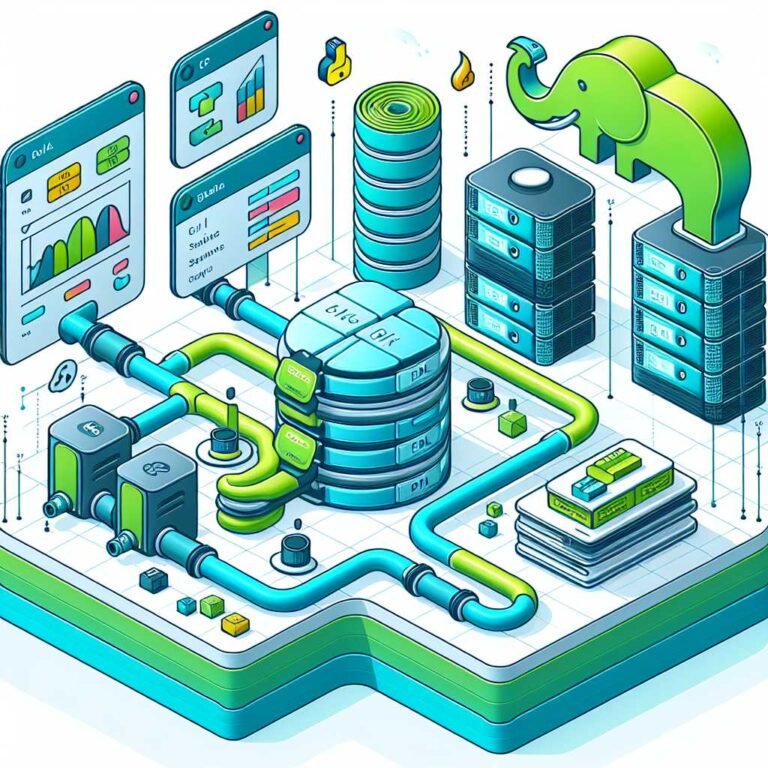Smart Data Automation: Build Bulletproof Data Pipelines with Apache Airflow and Prefect
If your on-call phone has ever buzzed at 2 a.m. because a pipeline failed, you know the cost of fragile data workflows. Now imagine the opposite: pipelines that schedule themselves, retry smartly, verify data quality, and surface issues before your stakeholders ever notice. That’s the promise of smart data automation—and it’s within reach today.
In this guide, I’ll show you how to design, schedule, monitor, and scale reliable data pipelines using Apache Airflow and Prefect. You’ll learn when to use each tool, the core design patterns that make pipelines resilient, and how to deploy with confidence on cloud-native infrastructure. Along the way, I’ll share practical tips, mental models, and pitfalls to avoid—so you can spend less time firefighting and more time delivering value.
Why Automate Data Pipelines Now
Modern data stacks have multiplied the number of sources, transformations, and consumers. With that growth comes operational complexity. Manual coordination, cron jobs, and ad hoc scripts rarely scale. Automation is no longer a nice-to-have; it’s the only way to ensure reliability at speed.
Here’s why that matters: – Reliability beats heroics. Automated retries, backoff, and alerting prevent late-night emergencies. – Faster iteration. When orchestration is consistent and observable, teams deploy changes with confidence. – Lower cost. Automation reduces manual toil and optimizes compute usage via smart scheduling and task parallelism. – Trust in data. Automated checks, data validation, and lineage make quality visible and enforceable.
Airflow and Prefect lead this space. They both orchestrate workflows, track dependencies, and give you a UI to monitor runs. But they differ in philosophy and ergonomics. Understanding those differences is step one.
Airflow vs. Prefect: How to Choose the Right Orchestrator
Let me explain the core mental model. Orchestrators do three big things: 1) Decide what to run (scheduling and dependency resolution). 2) Manage how it runs (execution and retries). 3) Show you what happened (observability and metadata).
Airflow is the veteran platform many data teams know and love. It’s pluggable, battle-tested, and rich in enterprise features. You define DAGs (Directed Acyclic Graphs) in Python, and a scheduler coordinates tasks across executors. Many providers exist for cloud services and databases. It’s an excellent choice if you’re already in the Airflow ecosystem, need mature features (like pools, priority weights, and a large operator library), or you plan to run it centrally for many teams. Explore it here: Apache Airflow.
Prefect takes a developer-first approach with a sleek Python API and dynamic workflows. It emphasizes local-first development, reactive scheduling, and observability. Flows feel like idiomatic Python functions, with dynamic mapping that scales elegantly. Prefect works great for teams that want dev speed, a smooth migration path from scripts to orchestration, or a cloud-managed control plane. Start with the docs: Prefect.
Key differences to guide your decision: – Programming model: Airflow uses DAGs and operators; Prefect uses flows, tasks, and a Pythonic decorator style. If you want fewer framework concepts, Prefect often feels lighter. – Dynamic tasks: Prefect’s dynamic mapping is ergonomic. Airflow supports dynamic DAGs and task mapping in newer versions, but Prefect’s developer experience is often simpler for complex fan-out/fan-in patterns. – Deployment model: Airflow typically runs as a centralized service (e.g., on Kubernetes with a scheduler, webserver, and workers). Prefect can run agents and workers that pull work from a control plane, which can simplify multi-environment setups. – UI and observability: Both offer UIs and lineage features, with growing support for standards like OpenLineage. Prefect’s UI is very friendly for developers; Airflow’s is robust and familiar to ops teams. – Ecosystem and operators: Airflow has a deep library of providers. Prefect has strong integrations and encourages wrapping bespoke logic as tasks cleanly.
Decision snapshots: – Choose Airflow if you need a central orchestrator across many domains, enterprise-ready controls, or you’re standardizing on a widely adopted platform. – Choose Prefect if developer velocity and dynamic workflows are paramount, or you want a quick path from notebook/script to production flows. – Use both if you have a core platform in Airflow and team-specific apps or ML workflows in Prefect—linked by events or datasets.
If you’d like a practitioner-friendly deep dive before you choose, Check it on Amazon.
Designing Smart, Reliable Workflows
Great pipelines share a few traits: they’re idempotent, deterministic, observable, and loosely coupled. Here’s how to design them.
1) Start with data contracts and schemas – Define inputs and outputs tightly. Validate shapes and types at boundaries. – Version your schemas; keep transformations backward compatible where possible. – Use data testing frameworks like Great Expectations to enforce expectations.
2) Make tasks idempotent – Running a task twice should yield the same result. Use partitioned writes, upserts, or snapshots. – Avoid side effects in the wrong places. Treat tasks like pure functions when possible.
3) Decouple orchestration from compute – Orchestrators coordinate; they should not do heavy lifting. – Offload compute to a data warehouse (e.g., Snowflake, BigQuery), a Spark cluster, or a containerized job runner. – Transformations are often cleaner in tools like dbt—trigger dbt jobs from your orchestrator for model lineage and testing.
4) Prefer event-driven or data-aware scheduling – Instead of fixed cron schedules, trigger runs when new data arrives or a dependency finishes. – Airflow’s dataset-aware scheduling reduces blind cron runs; Prefect’s reactive model enables event-based flows. – For streaming or near-real-time triggers, consider Apache Kafka or cloud pub/sub events like Google Cloud Pub/Sub.
5) Bake in observability – Emit metrics for run time, rows processed, error counts, and SLAs. – Include lineage and checkpoint metadata for quick diagnosis.
For step-by-step DAG and flow patterns with real code, View on Amazon.
Patterns that Pay Off
- Fan-out/Fan-in: Split work by partition (date, customer, region) to run tasks in parallel, then join for consolidation. Prefect’s dynamic mapping or Airflow’s task mapping newer APIs both help.
- Backfills: Keep historical runs deterministic. Pin versions of transformations and dependencies. Use run-level configs.
- Data quality gates: Fail early when data is missing or malformed; don’t propagate bad data downstream.
- Incremental processing: Track watermarks or file markers to process only what’s new. Log checkpoints.
- Retries with jitter: Use exponential backoff and jitter to reduce thundering herds against flaky services.
Scheduling and Dependency Management
Scheduling is more than “run at 2 a.m.” The best schedules reflect data availability, SLAs, and downstream needs.
- Cron vs. data-aware scheduling: Cron is simple but brittle when upstream data is late. Data-aware runs trigger as inputs arrive. Airflow’s datasets and Prefect’s events make this easier.
- Time zones and lateness: Normalize to UTC. Use SLAs to detect late tasks and escalate before stakeholders do.
- Dependencies: Keep DAGs small and composable. Avoid tangled graphs by grouping tasks into sub-flows or reusable components.
- Concurrency controls: Use resource pools and concurrency limits so a heavy job doesn’t starve others. Priority weights ensure critical pipelines get capacity.
- Catchup and backfill: Enable catchup when you need historical runs. For large backfills, batch by range and use guarded concurrency.
Pro tip: Validate your schedules with real-world upstream timelines. Map how long each step usually takes. That simple act prevents many 2 a.m. pages.
Monitoring, Alerting, and Observability
Pipelines are only as good as your ability to see when they’re unhealthy. Observability turns uncertainty into actionable insights.
What to monitor: – Task-level metrics: duration, retries, status codes, rows processed. – End-to-end SLAs: time from data arrival to publish. – Data quality metrics: null rates, distribution shifts, uniqueness, referential integrity. – System health: worker queue depth, executor load, scheduler latency.
Where to monitor: – Native UIs: Airflow’s web UI and Prefect’s dashboard both provide run views and logs. – Metrics stacks: Export metrics to Prometheus and visualize in Grafana. – Logs: Centralize logs (e.g., ELK, Cloud Logging). Structure logs for parsing. – Lineage: Use OpenLineage for cross-tool lineage that connects jobs, datasets, and runs.
Alerting best practices: – Alert on symptoms end-users care about (missed SLAs), not just low-level noise. – Route alerts to on-call with severity. Use runbooks for quick triage. – Add auto-remediation where safe (e.g., one extra retry with a longer backoff).
Want a ready-made checklist for observability in Airflow and Prefect, See price on Amazon.
Deployment: From Local Dev to Cloud Scale
Great pipelines start simple and grow gracefully. Your deployment strategy should evolve with them.
Local development – Keep a local stack for fast iteration. With Airflow, use a Docker Compose environment. With Prefect, run flows locally against a dev workspace. – Seed test data and fixtures. Reproducibility reduces the “works on my machine” tax.
Containers and orchestration – Package code as images for parity across environments. Add health checks and clear entrypoints. – On Kubernetes, choose the right executor: – Airflow Celery or KubernetesExecutor for elasticity. – Queue configuration matters; size workers based on task profiles. – For Airflow, managed platforms and distributions like Astronomer accelerate secure deployments. – For Prefect, agents pull work from the control plane, and you can run workers on Kubernetes, ECS, or VMs with minimal overhead.
Release workflow – Use GitOps for deployments (e.g., Argo CD or Flux) to promote changes through dev → staging → prod. Start here: Kubernetes. – Automate schema migrations and package version pinning. – Store secrets outside code with tools like HashiCorp Vault or managed secret stores.
Environment strategy – Isolate dev, staging, and prod with separate work queues and credentials. – Mirror infrastructure as closely as possible to reduce surprises. – Enable feature flags for safe rollouts; canary a subset of tasks before full promotion.
Cost, Performance, and Scale
The cheapest job is the one you don’t run. Design pipelines to do exactly what’s needed, only when needed, and as efficiently as possible.
Tuning strategies: – Partitioning: Process only new or changed partitions. Skip work with state-aware checks. – Caching: Persist intermediate results where it’s cost-effective. Avoid recomputing expensive steps. – Right-size workers: Match CPU/memory to task profiles. Overprovisioning wastes money; underprovisioning wastes time. – Concurrency: Batch or throttle to respect API rate limits. Use backpressure to prevent queue explosions. – Data locality: Run compute near data. Moving terabytes across zones is slower and pricier than moving code to the data. – Parallelism caps: Too much parallelism can crash downstream systems. Tune to the slowest dependency, not the fastest worker.
Warehouse and lake optimizations: – Prune scans with partitioning and clustering. – Use compressed columnar formats (Parquet) and pushdown predicates. – In dbt, prefer incremental models with unique keys and pre/post hooks for validation.
To compare runtime strategies and cost-saving patterns, Shop on Amazon.
Security and Compliance Basics
Security is table stakes. Orchestrators often have broad access; protect them like crown jewels.
- Principle of least privilege: Scope IAM roles to what each task needs, nothing more.
- Secrets management: Keep credentials out of code and variables. Use Vault or cloud KMS/secret stores.
- Network controls: Private subnets, security groups, and VPC peering prevent lateral movement.
- Encryption: Enable TLS in transit and encryption at rest for logs, metadata DBs, and artifacts.
- RBAC and audit logs: Restrict who can trigger backfills, edit DAGs, or view logs. Keep audit trails for changes and runs.
- PII handling: Tokenize or mask sensitive fields where possible. Enforce data contracts across pipelines that touch regulated data.
A Practical Blueprint: From Ingest to Insights
Use this reference flow as a starting point and adapt to your context:
- Ingest
- Trigger when a new file lands in object storage or a message hits a topic.
- Validate metadata (size, schema version). Quarantine invalid files.
- Stage
- Load raw data into a staging area with partitioned paths.
- Record lineage: source, timestamp, checksum.
- Transform
- Run dbt models or Spark jobs to clean, dedupe, and derive features.
- Enforce expectations (null thresholds, domain rules).
- Validate and gate
- Block publish if critical checks fail. Notify owners with clear error messages and a link to a runbook.
- Publish
- Materialize to serving layers (warehouse tables, feature stores, or APIs).
- Publish metadata to your catalog and update freshness indicators.
- Observe and alert
- Emit metrics for SLAs and data volumes.
- Page on-call only when user-facing SLAs are at risk.
Want to try it yourself with a guided project, Buy on Amazon.
Team Workflow and Best Practices
Smart automation is also about process. A few habits compound quickly:
- Version everything: pipeline code, schemas, configs, and infrastructure. Tag releases.
- Code reviews with checklists: idempotency, retries, observability, data contracts, and runbooks.
- Small, composable DAGs and flows: avoid “megadags.” Compose like Lego bricks.
- Rehearse failures: chaos days for pipelines catch gaps before production does.
- Document the happy path and the break-glass path: how to rerun, how to backfill, and when to roll back.
- Keep a performance budget: every new task should have a target runtime and memory footprint.
Common Pitfalls and How to Avoid Them
- Overloading the scheduler: Heavy computation in DAG code or callbacks slows scheduling. Keep heavy work in tasks, not the scheduler.
- Sensors that spin forever: Use smarter event triggers or timeouts with rescheduling sensors.
- Unbounded retries: Retries hide failures and burn cost. Cap retries, increase backoff, and alert early.
- Hidden state: Tasks relying on implicit state (temp files, mutable globals) break under parallelism. Make state explicit.
- No lineage: Without lineage, debugging is guesswork. Adopt metadata standards early.
External Resources You’ll Use Often
- Airflow docs: Apache Airflow
- Prefect docs: Prefect
- Data testing: Great Expectations
- Transformations: dbt
- Lineage: OpenLineage
- Observability: Prometheus and Grafana
- Orchestration on Kubernetes: Kubernetes
- Managed Airflow: Astronomer
- Secrets: HashiCorp Vault
FAQ: Airflow, Prefect, and Smart Automation
Q: Is Prefect better than Airflow? A: It depends on your needs. Prefect offers a very developer-friendly, Pythonic experience with dynamic mapping and a flexible control plane. Airflow is more established with a vast operator ecosystem and enterprise controls. Many teams succeed with either—and some use both.
Q: Can I migrate from cron jobs and scripts to an orchestrator easily? A: Yes. Start by wrapping scripts as tasks or flows, add logging and retries, then introduce data-aware triggers. Prioritize mission-critical scripts first and migrate iteratively.
Q: How do I monitor pipeline SLAs without drowning in alerts? A: Track end-to-end SLAs alongside task-level metrics. Alert on lateness and data health, not just failure counts. Use severity levels and runbooks for quick triage.
Q: Should I run Airflow or Prefect on Kubernetes? A: Kubernetes provides elasticity and isolation, which helps at scale. Airflow commonly runs with Celery or KubernetesExecutor; Prefect workers run well on K8s too. For small teams, managed platforms can reduce ops burden.
Q: How do I ensure pipelines are idempotent? A: Write deterministic tasks, use partitioned writes and upserts, and avoid hidden side effects. Store checkpoints and use task parameters as the single source of truth.
Q: What’s the best way to handle backfills? A: Pin code and dependencies to a specific version, batch by time ranges, throttle concurrency, and capture a snapshot of inputs. Validate outputs as you go to catch drifts.
Q: Can Airflow trigger Prefect (or vice versa)? A: Yes. Use API calls, webhooks, or event topics to bridge orchestrators. Datasets or event messages can signal when to run downstream pipelines.
Q: How do I choose between time-based and event-driven scheduling? A: If your upstream arrivals are predictable and stable, time-based can be fine. When arrivals vary or SLAs are tight, event-driven or data-aware scheduling is more reliable and cost-effective.
Q: What about data lineage across tools? A: Adopt a standard like OpenLineage and ensure each task emits metadata. This creates a graph linking sources, jobs, and datasets across Airflow, Prefect, warehouses, and transformation tools.
Final Takeaway
Smart data automation isn’t magic—it’s a set of consistent practices and the right tools. Use Airflow and Prefect to orchestrate, validate, and observe your pipelines so they run smoothly and recover on their own. Start small, automate the next failure before it happens, and keep tightening your feedback loops. If this was helpful, consider subscribing or exploring more deep dives on data engineering best practices—your future self (and your on-call schedule) will thank you.
Discover more at InnoVirtuoso.com
I would love some feedback on my writing so if you have any, please don’t hesitate to leave a comment around here or in any platforms that is convenient for you.
For more on tech and other topics, explore InnoVirtuoso.com anytime. Subscribe to my newsletter and join our growing community—we’ll create something magical together. I promise, it’ll never be boring!
Stay updated with the latest news—subscribe to our newsletter today!
Thank you all—wishing you an amazing day ahead!
Read more related Articles at InnoVirtuoso
- How to Completely Turn Off Google AI on Your Android Phone
- The Best AI Jokes of the Month: February Edition
- Introducing SpoofDPI: Bypassing Deep Packet Inspection
- Getting Started with shadps4: Your Guide to the PlayStation 4 Emulator
- Sophos Pricing in 2025: A Guide to Intercept X Endpoint Protection
- The Essential Requirements for Augmented Reality: A Comprehensive Guide
- Harvard: A Legacy of Achievements and a Path Towards the Future
- Unlocking the Secrets of Prompt Engineering: 5 Must-Read Books That Will Revolutionize You







